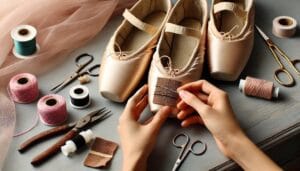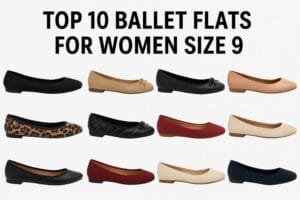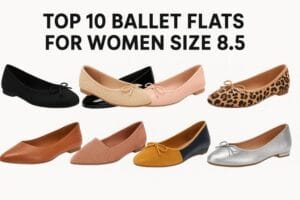How to Add Extra Padding to Existing Ballet Flats (13 FAQs)
- Published on -
- By - Sophia Webster
- Reviewed by - Tory Burch
- Reading Time - 13 Minutes
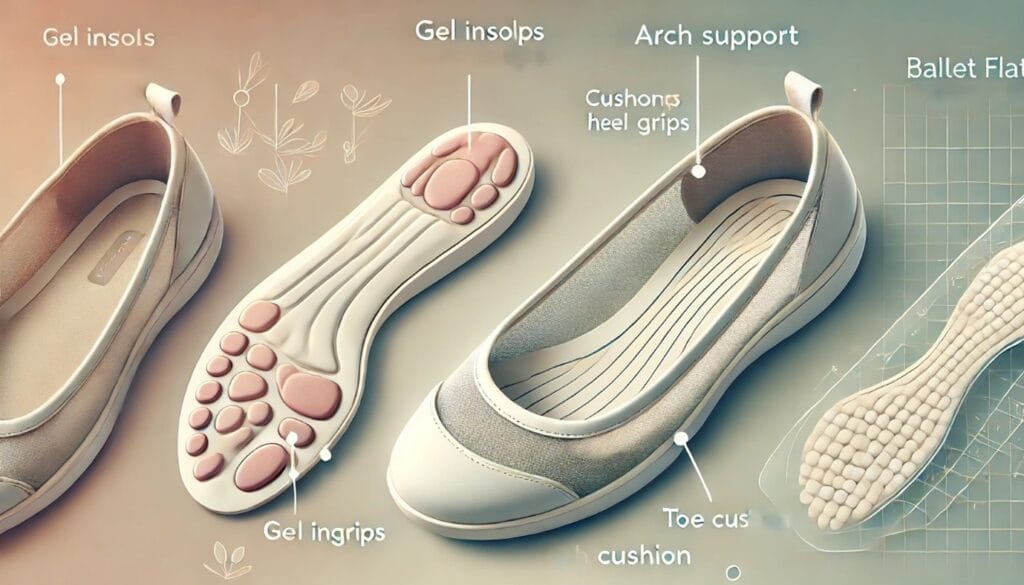
Share this Post
Recent Posts
About Author
Sophia Webster
In this article, we answer 13 common questions on how to add extra padding to your existing ballet flats, ensuring a softer and more supportive fit.
Q1. How to add extra padding to existing ballet flats?
Ballet flats are a style staple, but slipping no-show socks can be a pesky problem. The solution? Extra padding! Whether you prefer tape, non-slip sprays, or DIY inserts, here are practical tips to keep everything firmly in place.
Silicone Tape for Instant Grip
Apply silicone tape to the inside of your ballet flats.
- Tip: Clean the interior surface first, then line the footbed or arch area with strips of silicone tape.
- Solution: The tape acts as a cushion and grip, reducing sock movement.
Non-Slip Sprays for a Discreet Boost
Invest in a non-slip spray designed for footwear.
- Tip: Spray a light, even coat on the inner surfaces of your flats.
- Solution: Once dry, the spray creates a tacky layer that helps keep your socks secure without altering the shoe’s look.
DIY Thin Insoles for Extra Padding
Try adding a slim, cushioned insole designed for ballet flats.
- Tip: Choose an insole with a non-slip backing and trim it to fit your shoe perfectly.
- Solution: The extra padding not only enhances comfort but also minimizes sock slippage.
Craft Foam or Gel Inserts for Custom Comfort
Consider using craft foam or gel inserts for a bespoke solution.
- Tip: Cut the foam or gel to match the shape of your flat’s interior.
- Solution: These inserts provide extra cushioning and create a snug environment to keep socks in place.
Double-Sided Fabric Tape for a Subtle Fix
For a more temporary fix, use double-sided fabric tape on the shoe’s interior edges.
- Tip: Stick small strips along the rim where your foot rests.
- Solution: This tape offers a secure hold for both your sock and your foot, ensuring a friction-friendly fit.
Q2. What kinds of insoles or cushions work best with ballet flats to add padding without compromising fit?

Ballet flats are synonymous with elegance, but they sometimes sacrifice a bit of comfort. Adding the right insoles or cushions can transform your flats into all-day supportive shoes without compromising their fit. Here are some engaging tips and solutions to help you find the perfect insole for your ballet flats:
Memory Foam Insoles
Tip: Look for thin, contoured memory foam insoles that mold to your foot’s shape.
Solution: These insoles provide excellent cushioning and help absorb shock while maintaining a slim profile that won’t crowd your feet.
Gel-Based Cushions
Tip: Choose gel insoles with a low-profile design to ensure a secure fit.
Solution: Gel cushions offer superb shock absorption and a cooling effect, giving your feet comfort without adding bulk to your ballet flats.
Orthotic Inserts
Tip: Consider custom orthotic inserts if you need extra arch support along with padding.
Solution: Designed to provide targeted support, these insoles can improve foot alignment while remaining discreet in slim-fitting ballet flats.
Peel-and-Stick Cushions
Tip: Use adhesive-backed cushions for an easy, temporary boost of comfort.
Solution: These cushions stick directly to the insole, allowing you to adjust cushioning where you need it most without altering the shoe’s overall fit.
Q3. Can removable orthotics be used in ballet flats, and how do I ensure they stay securely in place?
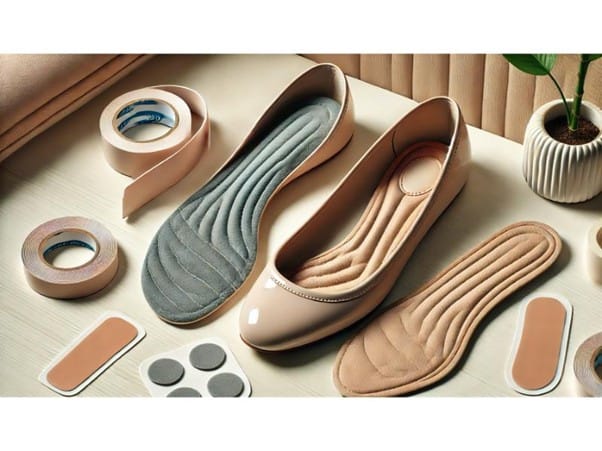
Ballet flats are the epitome of style and comfort, but adding removable orthotics might seem challenging. The good news is, with a few smart tips, you can enjoy the benefits of orthotics without compromising your chic look. Here’s how to ensure your orthotics stay securely in place:
- Choose a Slim, Custom-Fit Orthotic
Opt for a low-profile or custom-molded orthotic designed to fit comfortably in tighter spaces. A slim design minimizes bulk and reduces the risk of shifting inside your flats. - Ensure Proper Shoe Fit
Your ballet flats should have a bit of extra room to accommodate orthotics without cramping your foot. If the shoe feels too snug, consider a slightly larger size or a style with a wider toe box for a more secure fit. - Trim to Perfection
Many orthotics come with guidelines for trimming. Adjust the edges to match the contours of your flats. This custom trim not only improves comfort but also prevents the orthotic from moving around during your day. - Secure with Non-Slip Solutions
Use non-slip adhesive pads or a small dab of double-sided tape on the underside of the orthotic. These extra measures help keep the insert firmly in place, even when you’re on the move. - Test and Tweak
After inserting your orthotics, take a short walk indoors to assess comfort and stability. If you notice any slippage, re-adjust the trim or adhesive placement until you find the perfect secure fit.
Q4. Are there specific heel grips or adhesive pads recommended for extra comfort and preventing slippage in ballet flats?

Ballet flats are the epitome of chic style and comfort—but slipping socks or shifting heels can quickly become a nuisance. Here are some engaging tips and specific recommendations to keep your feet secure and comfortable all day long.
Try Silicone Heel Grips
Silicone heel grips are a popular, non-invasive solution. They adhere directly to the inside of your flats and provide extra friction.
Tip: Look for grips with extra cushioning to enhance comfort without compromising the sleek look of your flats.
Use Adhesive Pads with Cushioning
Adhesive pads not only prevent slippage but also add a layer of shock absorption. These pads are designed to stick firmly inside your shoe’s heel area.
Solution: Brands like Dr. Scholl’s offer adhesive heel cushions that work well with various shoe styles. Check reviews to pick one that balances grip with comfort.
Invest in Cushioned Heel Inserts
Heel inserts are great for filling any extra space in your ballet flats, ensuring a snug fit. They often combine cushioning with non-slip properties.
Tip: Choose inserts that are thin enough not to alter your shoe fit drastically but firm enough to stabilize your foot.
Consider Double-Sided Tape for Extra Security
If you’re in a pinch, a small strip of double-sided tape applied discreetly inside the heel area can make a big difference.
Solution: Use a tape that’s designed for skin contact to avoid irritation and test a small patch before full application.
Q5. How do I avoid making my flats too tight or uncomfortable when adding additional padding?
Enhancing your flats with extra padding can boost comfort and support, but too much can make them tight or uncomfortable. Here are some practical tips and solutions to strike the perfect balance:
Choose Slim, Purpose-Built Inserts
Opt for padded insoles designed specifically for ballet flats or low-profile shoes. These are engineered to provide cushioning without adding bulk.
Tip: Look for insoles made of gel or memory foam that are thin yet effective.
Test for a Gradual Transition
Before committing to long wear, try your padded flats for short periods. This helps you gauge comfort and identify any tightness early on.
Solution: Wear them around the house to allow your feet to adjust gradually.
Customize the Padding to Your Needs
If the insert feels too large, consider trimming the edges or repositioning it so that it only cushions the necessary areas (like the heel or ball of the foot).
Tip: Use sharp scissors and measure carefully to avoid overcutting.
Ensure Proper Shoe Fit
Additional padding might require a slightly looser fit. If your flats already feel snug, consider sizing up or looking for shoes with adjustable features like elastic inserts.
Solution: Consult sizing charts and try on different brands known for a roomy fit.
Monitor Long-Term Comfort
Pay attention to how your feet feel over time. If discomfort persists, it might be time to adjust the type of padding or seek professional advice from a podiatrist.
Tip: Regularly check the condition of your inserts and replace them when they lose their shape or support.
Q6. Is it possible to have a shoe repair professional permanently add cushioning or padding to ballet flats?
Ever wondered if your favorite ballet flats could get a permanent comfort boost? Many shoe repair professionals now offer custom modifications, including the addition of cushioning or padding. Here’s a short, engaging guide with tips and solutions to explore your options.
Consult a Professional
Tip: Find a trusted shoe repair specialist with experience in modifications.
Solution: Ask for examples of similar work. A reputable professional will discuss the feasibility, materials, and impact on the shoe’s design.
Choose the Right Materials
Tip: Look for high-quality cushioning materials, like foam or gel inserts that blend durability with comfort.
Solution: Your repair expert can source materials that are designed to integrate permanently without compromising the style of your flats.
Custom Insole Integration
Tip: Consider a custom insole that’s built into the shoe rather than a removable insert.
Solution: This method can offer long-lasting support, ensuring the cushioning remains securely in place even with frequent use.
Understand the Trade-Offs
Tip: Weigh comfort against any potential changes in fit or aesthetics.
Solution: A professional will advise if the added cushioning might alter the shoe’s shape or require further adjustments for optimal comfort.
Post-Modification Care
Tip: Ask for care instructions to maintain the cushioning over time.
Solution: Regular check-ups with your repair specialist can ensure that your enhancements continue to perform well, keeping your ballet flats as comfortable as they are stylish.
Q7. How can I make my ballet flats more comfortable?
Ballet flats are the perfect blend of style and ease—but comfort isn’t always guaranteed. With a few simple tweaks, you can transform your flats into a dream to wear all day. Here are some engaging tips and solutions:
Cushioning Insoles
Tip: Add a pair of cushioned insoles to provide extra padding and support.
Solution: Look for thin, flexible insoles that offer arch support without changing the fit of your ballet flats.
Gel or Foam Pads
Tip: Use gel or foam pads on pressure points like the heel and ball of your foot.
Solution: These pads reduce friction and provide targeted cushioning, easing discomfort during long hours of wear.
Stretch Them Out
Tip: If your flats feel a bit snug, gently stretching them can make a world of difference.
Solution: Use a hairdryer on a low setting while wearing thick socks, or take them to a professional for stretching to create a roomier, more comfortable fit.
Secure a Better Fit
Tip: Loose-fitting flats can lead to slipping and discomfort.
Solution: Try heel grips or tongue pads to secure your foot in place, ensuring a snug and supportive fit.
Invest in Quality Materials
Tip: Softer, high-quality materials mold to your feet over time.
Solution: Opt for ballet flats made from genuine leather or supple fabric, which adapt to your foot’s shape for added comfort.
Q8. Can you put insoles in ballet flats?
Ballet flats are stylish and versatile, but they can sometimes lack the support your feet need. Fortunately, you can add insoles to boost comfort and cushioning without sacrificing style. Here are some engaging tips and solutions to help you make the switch seamlessly:
Choose a Slim, Flexible Insole
Tip: Look for insoles specifically designed for flats.
Solution: Opt for thin gel or foam insoles that add cushioning without altering the shoe’s natural shape.
Check the Shoe’s Interior Space
Tip: Ensure your ballet flats have enough room to accommodate an extra layer.
Solution: Insert the insole and test the fit; if it feels tight, consider trimming the insole or selecting a lower-profile option.
Use Removable Insoles
Tip: Start with shoes that feature removable insoles.
Solution: Removable insoles let you easily swap them for custom options, ensuring a perfect fit and extra arch support where needed.
Customize for Extra Support
Tip: Consider insoles with adjustable arch support for personalized comfort.
Solution: Use adhesive insole inserts that you can reposition, giving you tailored cushioning without compromising the shoe’s design.
Test and Adjust Gradually
Tip: Ease into your new setup by wearing the insoles for short periods.
Solution: Gradually increase the wear time, making any necessary adjustments to ensure maximum comfort throughout the day.
Q9. Is there padding in ballet shoes?
When it comes to ballet shoes, comfort and performance are key. But do they come with padding? The answer isn’t a simple yes or no—it depends on the type of ballet shoe and your specific dance needs. Here are some tips and solutions to help you navigate the padded vs. non-padded world of ballet shoes:
Understand the Design
Traditional Ballet Slippers: These often have minimal padding. The design is intended to offer maximum sensitivity to the floor, giving dancers essential feedback for balance and technique.
Tip: If you’re focused on technique and performance, embrace the minimal cushioning for that natural connection.
Explore Padded Options for Comfort
Padded Ballet Shoes: Some modern designs include extra cushioning for enhanced comfort, especially for beginners or for long rehearsals.
Solution: Look for brands that specifically market “comfort” or “cushioned” ballet shoes if you need extra support.
Custom Solutions for Personal Comfort
Insoles and Pads: Even if your shoes aren’t heavily padded, you can add removable cushioned insoles or gel pads.
Tip: Experiment with different inserts to find the perfect balance between comfort and floor sensitivity.
Consider the Fit
Proper Sizing: Ill-fitting shoes can lead to discomfort regardless of padding. A snug, supportive fit is essential.
Solution: Always get your ballet shoes professionally fitted or measure carefully, and replace them when they lose their shape.
Q10. How do I stop my ballet flats from hurting?
Ballet flats are a timeless style, but they can sometimes cause discomfort. If your flats are hurting your feet, try these quick and effective tips to keep you moving comfortably all day.
Find the Perfect Fit
Tip: Ensure your ballet flats aren’t too tight or too loose.
Solution: Shop for flats in the afternoon when your feet are at their largest and try on different sizes. A proper fit minimizes friction and pressure points.
Break Them In Gradually
Tip: Don’t wear new flats all day right away.
Solution: Start by wearing them for short periods at home. This gradual break-in helps the shoe material soften and mold to your foot shape, reducing stiffness and discomfort.
Add Cushioned Inserts
Tip: Boost comfort with a little extra cushioning.
Solution: Invest in gel or foam insoles designed for flats. These inserts absorb shock, provide arch support, and relieve pressure from your heels and toes.
Use Ball-of-Foot Pads
Tip: Alleviate pain in high-pressure areas.
Solution: Apply cushioned gel pads or adhesive cushioning on the ball of your foot. This extra padding eases pressure and can prevent blisters during long days on your feet.
Stretch and Massage Your Feet
Tip: Keep your feet relaxed and flexible.
Solution: Perform simple foot stretches or a quick massage after wearing your flats. This improves circulation, eases muscle tension, and prevents soreness.
Q11. How to make ballet flats more comfortable?
Ballet flats are a timeless staple, but they can sometimes leave your feet feeling less than pampered. Here are a few engaging tips with practical solutions to transform your ballet flats into a haven of comfort.
Upgrade with Cushioned Insoles
Tip: Replace the thin factory insole with a cushioned, gel-based insert.
Solution: Choose memory foam or gel insoles that provide extra arch support and shock absorption, turning every step into a soft landing.
Add Heel Pads for Extra Cushioning
Tip: Alleviate pressure on your heels by applying padded inserts.
Solution: Stick-on or removable heel pads help reduce friction and pressure, making long walks much more comfortable.
Break Them In Gradually
Tip: Don’t wear new flats all day right away.
Solution: Start by wearing them at home for short periods. Gradually increase usage to allow the material to mold to your foot shape, minimizing stiffness and discomfort.
Use Orthotic Inserts for Customized Support
Tip: Enhance the fit with supportive orthotic inserts.
Solution: These inserts offer targeted arch support and correct alignment issues, reducing fatigue and providing a personalized comfort boost.
Choose the Right Size and Stretch if Needed
Tip: A snug but not tight fit is key.
Solution: If your flats feel too tight, use a shoe stretcher or gently warm them with a hair dryer (while wearing thick socks) to relax the material for a bet
Q12. How do you fix ballet flats that are too big?
Ballet flats are stylish and comfortable, but what happens when they’re just too roomy? Whether you’re dancing through your day or simply walking with confidence, these simple tips will help transform oversized flats into a snug, secure fit.
Add Insoles or Cushioned Inserts
Tip: Slip in a cushioned insole to fill the extra space.
Solution: Insoles not only add comfort but also provide extra padding, helping your feet stay in place and giving your flats a tighter feel.
Use Heel Grips or Pads
Tip: Stick on adhesive heel grips to prevent slipping.
Solution: Heel grips create friction at the back of the shoe, ensuring your foot doesn’t slide out, which is especially useful if your flats feel loose around the heel.
Opt for Thicker Socks or Booties
Tip: Wear thicker socks or ankle booties under your flats.
Solution: Extra fabric can help fill in the gap and provide additional cushioning, enhancing the overall snugness of your shoes.
Try Tongue Pads
Tip: Apply tongue pads inside the shoe.
Solution: These pads can raise your foot slightly, reducing extra space at the front and preventing your foot from slipping forward.
Professional Adjustments
Tip: Visit a cobbler for a custom fix.
Solution: For a long-term solution, a professional alteration can trim excess material or add custom padding, ensuring a perfect, comfortable fit.
Q13. How can I make my flats more supportive?
Flats are a go-to for everyday style, but they might not always offer the support your feet need. Here are some engaging and practical tips to make your flats more supportive—each with a simple solution.
Invest in Quality Insoles
Tip: Add cushioned or orthotic insoles to your flats.
Solution: Look for memory foam or gel insoles that provide arch support and absorb shock, transforming your flats into a comfortable, supportive base.
Incorporate Arch Supports
Tip: Enhance the natural arch support of your feet.
Solution: Use removable arch supports that slide easily into your flats, ensuring that your feet get extra stability during long days.
Use Gel Heel Cushions
Tip: Cushion your heels to reduce impact.
Solution: Place a gel heel cushion inside your flats. This not only adds comfort but also improves overall stability by minimizing heel slippage.
Ensure a Proper Fit
Tip: Start with well-fitting shoes.
Solution: Choose flats that offer a snug yet comfortable fit. A better-fitting shoe naturally provides improved support and reduces the need for extra modifications.
Customize with Inserts
Tip: Tailor your support to your foot’s needs.
Solution: Consider specialized inserts designed for overpronation or other specific foot concerns. These can be custom-fitted to enhance support exactly where you need it.
Conclusion:
To add extra padding to ballet flats, it’s best to use specialized insoles or cushions that fit well without compromising comfort. Removable orthotics and adhesive heel grips can provide added support if they stay securely in place, while professional modifications may offer a permanent solution. The key is to enhance cushioning without making the shoes too tight or disrupting their fit.



